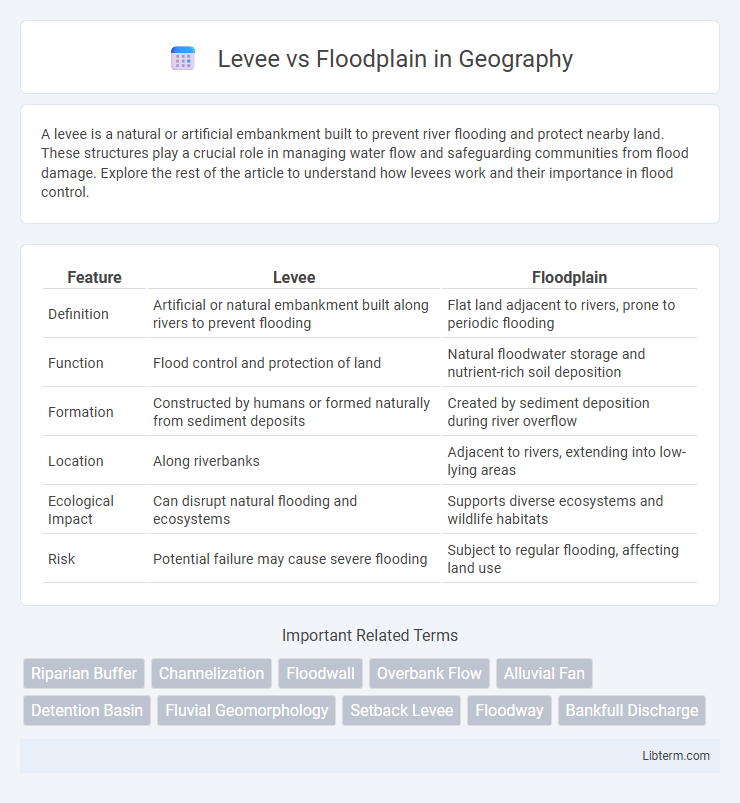A levee is a natural or artificial embankment built to prevent river flooding and protect nearby land. These structures play a crucial role in managing water flow and safeguarding communities from flood damage. Explore the rest of the article to understand how levees work and their importance in flood control.
Table of Comparison
| Feature | Levee | Floodplain |
|---|---|---|
| Definition | Artificial or natural embankment built along rivers to prevent flooding | Flat land adjacent to rivers, prone to periodic flooding |
| Function | Flood control and protection of land | Natural floodwater storage and nutrient-rich soil deposition |
| Formation | Constructed by humans or formed naturally from sediment deposits | Created by sediment deposition during river overflow |
| Location | Along riverbanks | Adjacent to rivers, extending into low-lying areas |
| Ecological Impact | Can disrupt natural flooding and ecosystems | Supports diverse ecosystems and wildlife habitats |
| Risk | Potential failure may cause severe flooding | Subject to regular flooding, affecting land use |
Introduction to Levees and Floodplains
Levees are engineered embankments constructed to prevent river or coastal flooding by containing or redirecting water flow. Floodplains are natural low-lying areas adjacent to rivers or streams that periodically flood, providing essential ecological functions like water filtration and habitat diversity. Understanding the interaction between levees and floodplains is critical for effective flood risk management and environmental conservation.
Understanding Levee Structures
Levee structures are engineered embankments designed to prevent river or coastal floodwaters from inundating adjacent land, often constructed from compacted earth, concrete, or rock. These barriers function by redirecting or containing water flow, protecting infrastructure and communities within floodplains, which are naturally vulnerable low-lying areas along rivers prone to periodic flooding. Understanding the material composition, height, and maintenance requirements of levees is critical for assessing their effectiveness in flood risk management and minimizing potential breaches during high water events.
What Defines a Floodplain?
A floodplain is a flat or nearly flat land area adjacent to a river or stream that experiences periodic inundation during high water events. It is defined by its natural capacity to absorb and channel excess water, helping to reduce flood risks downstream. Vegetation, soil type, and topography play crucial roles in the floodplain's ability to store floodwaters and support diverse ecosystems.
Levee Functions and Purposes
Levees serve as engineered embankments designed to prevent floodwaters from inundating adjacent land, protecting urban areas, agricultural fields, and critical infrastructure. They function by containing river flow within defined channels, reducing flood risk and enabling controlled water management during high discharge events. The primary purpose of levees is to safeguard property and lives by minimizing flood damage and facilitating economic stability in flood-prone regions.
The Ecological Role of Floodplains
Floodplains serve as crucial ecological zones that absorb excess water during floods, reducing the impact on levees and downstream areas. These areas support diverse habitats for wildlife, including fish spawning grounds and migratory bird stopovers, promoting biodiversity. Floodplains also enhance water quality by filtering sediments and nutrients, contributing to healthier ecosystems compared to engineered levees.
Advantages of Levees
Levees provide critical flood protection by acting as engineered barriers that prevent river waters from inundating adjacent lands, thereby safeguarding homes, infrastructure, and agricultural areas. Their controlled construction allows for targeted defense in high-risk flood zones, minimizing economic losses and enhancing community resilience. Levees also facilitate land development and urban expansion by stabilizing floodplain boundaries, enabling safer human activities near waterways.
Benefits of Natural Floodplains
Natural floodplains provide critical benefits including water filtration, habitat diversity, and groundwater recharge, which levees often disrupt by confining floodwaters. Floodplains absorb and slow floodwaters, reducing downstream flood peaks and minimizing erosion, while levees can increase flood risk by channeling water and causing higher flood stages. Preserving floodplain ecosystems supports biodiversity and improves resilience to climate change impacts, offering sustainable flood management beyond the protection levees provide.
Levee Risks and Limitations
Levee systems provide critical flood protection by creating barriers along rivers but pose significant risks such as levee failure due to overtopping or structural weaknesses, leading to catastrophic flooding events. These structures can give a false sense of security, encouraging development in flood-prone areas and increasing potential damage when levees do fail. Limitations include high maintenance costs, vulnerability to extreme weather events, and disrupted natural floodplain processes that reduce ecosystem resilience and floodwater absorption.
Floodplain Management Strategies
Floodplain management strategies focus on preserving the natural functions of floodplains by implementing zoning regulations, restoring wetlands, and promoting sustainable land use to reduce flood risks. Unlike levees that act as physical barriers, floodplain management emphasizes non-structural approaches such as floodplain mapping, elevating structures, and relocating vulnerable communities. These methods enhance floodwater absorption, reduce property damage, and support ecosystem health, making them essential for long-term flood resilience.
Levees vs. Floodplains: Key Differences and Considerations
Levees are engineered embankments designed to prevent floodwaters from spilling into adjacent lands, whereas floodplains are natural low-lying areas that absorb excess water during floods, providing ecological benefits like groundwater recharge and habitat support. While levees offer immediate protection to developed areas by containing river flow, they can exacerbate downstream flooding and reduce natural sediment deposition essential for soil fertility. Floodplain management emphasizes preserving or restoring these areas to mitigate flood risks sustainably and maintain biodiversity, highlighting the trade-offs between structural defenses and natural floodplain functions.
Levee Infographic

 libterm.com
libterm.com